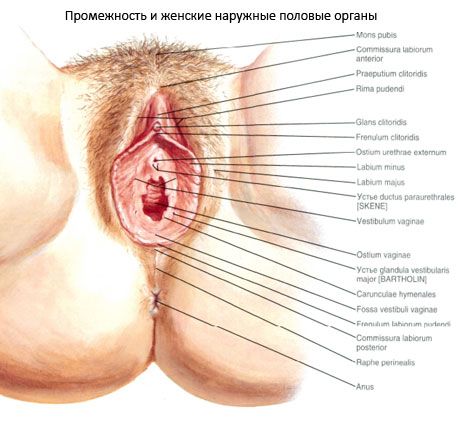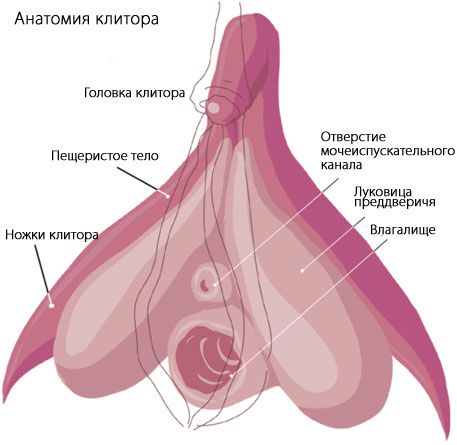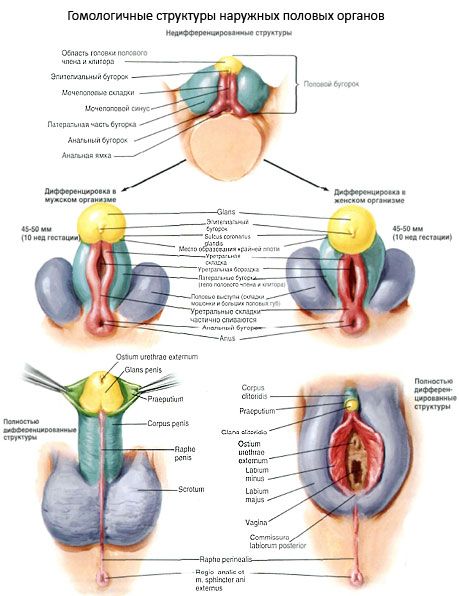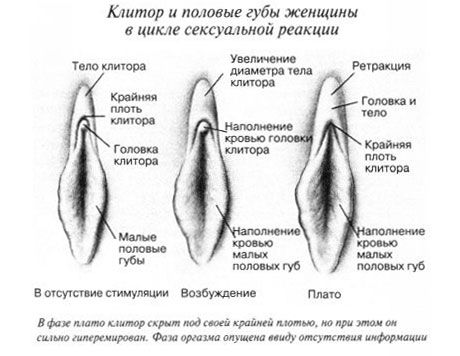Medical expert of the article
New publications
Clitoris
Last reviewed: 04.07.2025

All iLive content is medically reviewed or fact checked to ensure as much factual accuracy as possible.
We have strict sourcing guidelines and only link to reputable media sites, academic research institutions and, whenever possible, medically peer reviewed studies. Note that the numbers in parentheses ([1], [2], etc.) are clickable links to these studies.
If you feel that any of our content is inaccurate, out-of-date, or otherwise questionable, please select it and press Ctrl + Enter.
Clitoris (Latin clitoris from Latin clitorido - "to tickle") or obsolete Russian pokhotnik - an unpaired formation in female mammals. Homologous to the penis in males. Unlike the penis, it does not include the urethra, except for the clitoris of the spotted hyena, which is considered a pseudopenis.
Read also:
In women, it is considered the leading sensitive erogenous zone. It is located behind and below the anterior commissure of the labia majora. The clitoris resembles an inverted Latin letter Y, somewhat compressed from the sides. The clitoris has a head (glans clitoridis), bodies (corpus clitoridis), two cavernous bodies (corpora cavernosum clitoridis) and two legs (crura clitoridis). It also contains a large number of vessels and nerve endings.
History of the study of the clitoris
The history of the study of the clitoris contains a large number of "discoveries" of this structure in different countries and in different centuries. Among other things, different terminology was used. Hippocrates used the term columella (small column). Avicenna called the clitoris albatra or virga (rod). Abulcasis, another Arab physician, called it tentigo (tension). Realdo Colombo used the definitions amoris dulcedo (love's delicacy), sedes libidinis (seat of lust) and "fly of Venus". The knightly scholastic Albertus Magnus emphasized the similarity between the male and female genitals, using the term virga to denote both male and female genitalia. The ancient Romans used the outrageous word landīca to denote the clitoris.
Regnier de Graaf insisted that the nymph should be distinguished from the clitoris, so he proposed to call this anatomical structure only the clitoris. Since the 17th century, this name has become generally accepted, while the nymph was initially called the vulva, and later the labia minora. The Greek word κλειτορίς, quite likely comes from "tickling", although it can also mean "small hill"; in other words, ancient authors had the opportunity to use a play on words. Linguist Marcel Cohen devoted a chapter in his book to studying the origin of the word "clitoris", although he did not come to any definite conclusions.
Opening of the clitoris
The discovery of the clitoris is often attributed to Realdo Colombo, a 16th-century Italian anatomist. In 1559, he published De anatomica, in which he described "the female pleasure site during sexual intercourse" and called himself the discoverer of the clitoris. Colombo wrote:
Since no one has described these appendages and their functionality, and if it is possible to give a name to the organs I have found, then it should be called the love or sweetness of Venus...
Colombo also mentioned the clitoris in a section on rare anatomical structures - he described an Ethiopian lady whose clitoris was the size of a little finger and whose vaginal opening was quite narrow.
Andreas Vesalius, a friend and mentor of Colombo, with whom the relationship later deteriorated, did not accept this discovery. Vesalius thought that female genitalia were a symmetrical reflection of male genitalia. Following this doctrine, the penis was placed in accordance with the vagina, and the clitoris could not find a suitable male organ. Protesting against Colombo's thoughts, Vesalius wrote:
It is useless to blame others for incompetence on the basis of a freak of nature that you may have observed in some of the fairer sex, and you will not be able to identify this new and useless part in healthy women. I believe that this structure is most often found in hermaphrodites, in whom the genitals are clearly expressed, as Paul of Aegina describes, although I have never seen in any lady a penis (which Avicenna called albarata, and the Greeks called the clitoris an enlarged nymph and classified as a disease) or even the rudiment of a tiny phallus.
Colombo's claim to the clitoris was challenged by his successor, Gabriele Faloppio, who considered himself the discoverer of the clitoris. In his own work, Observations anatomicae, written in the 1550s and published in 1561, he also suggested that this part of the female anatomy was so difficult to find that he was the first to discover it; others reported the clitoris either on his own authority or on that of his students.
Caspar Bartholin, a 17th-century anatomist, rejected both claims, arguing that the clitoris had been widely known to medical science since the 2nd century. Before Colombo, the clitoris had also been described by Arab, Greek, and Persian physicians, although its function was often misinterpreted. In his 1545 publication De Dissectione Partium Corporis Humani, the French anatomist Charles Estienne attributed the clitoris to urination. Colombo was likely the first to describe the sexual function of the clitoris, but even this is disputed. The Italian philosopher and doctor of medicine Pietro d'Abano wrote in his book Conciliator differentiarum philosophorum et medicorum that friction of the superior oriphis within the pubis causes arousal in women, although he did not analyze the anatomy of the clitoris in detail.

Structure of the clitoris
According to research by Australian urologist Helen O'Connell, the clitoris has two cavernous bodies (corpus cavernosum clitoridis), the head of the clitoris (lat. glans clitoridis), the legs of the clitoris (lat. crus clitoridis) and two bulbs of the vestibule of the vagina (otherwise clitoral bulbs) (bulbus vestibuli vaginae). The fibrous membranes that surround the cavernous halves of the body of the clitoris converge over the median surfaces and form a septum to which elastic and smooth muscle fibers are attached.

The cavernous body of the clitoris divides above the urethra into two crura that encircle the urethra and vagina on both sides and end in the form of two bulbs, forming the clitorourethrovaginal complex. The body of the clitoris is connected to the ischiopubic branch (ramus ischiopubicus) by the root, while two small ischiocavernosus muscles (musculus ischiocavernosus) attach to the crura on the inside of the glans and cavernous bodies of the clitoris, and form a complex of nerve endings. The blood supply to the clitoris is provided by branches of the internal pudendal artery (arteria pudenda interna). Three key zones can be distinguished in the visible part of the clitoris: the glans, the frenulum of the clitoris, and the clitoral hood. Anatomically, the clitoris corresponds to the male penis.

The head of the clitoris
The head of the clitoris (glans clitoridis) is the most sensitive part of a woman's body; it has many blood vessels and nerve endings. In some women, the head is so sensitive that its direct stimulation (during masturbation or cunnilingus) can cause unpleasant sensations. The head of the clitoris is covered by a fold of skin (the so-called clitoral hood) or the foreskin. In a calm state, the head of the clitoris is either not noticeable at all, or only a small part of it is noticeable. During sexual arousal, the clitoris becomes erect and the head protrudes forward.
Frenulum of the clitoris
The frenulum of the clitoris is a fold of skin that connects the anterior ends of the labia minora and the undersurface of the clitoris (frenulum clitoridis)
 [ 6 ], [ 7 ], [ 8 ], [ 9 ], [ 10 ]
[ 6 ], [ 7 ], [ 8 ], [ 9 ], [ 10 ]
Clitoral hood
The clitoral hood (Latin: preputium clitoridis) is usually visible during a gynecological examination, but in some women who have plump labia majora, the clitoris is not visible.
The most famous place of female intimate piercing. First of all, when they talk about a pierced clitoris, they mean a horizontal puncture of the clitoral hood, beautifully decorated with a ring, barbell, micro banana, etc. A piercing of the clitoris is considered one of the most difficult and is possible only in case of biological compatibility with this type of piercing (a small, poorly visible clitoris cannot be pierced).
Clitoris during intercourse
For most women, the clitoris is considered the main erogenous zone. It is for this reason that the clitoris is considered the main source of pleasant feelings that a woman experiences during sexual intercourse. At the same time, due to the distinctive features of female anatomy, during vaginal intercourse, the man's penis does not directly affect the clitoris, since the movements of the male organ occur in the vagina, and there is no direct effect directly on the clitoris.
Stimulation of the clitoris during sexual intercourse occurs indirectly, through the adjacent parts of the female genitals, for example, by stretching and twitching the labia minora. Traditionally, this is sufficient to increase arousal and achieve orgasm, although in some cases women resort to additional stimulation of the clitoris with their fingers.

In most cases, the clitoris is not immediately aroused. This is evident from the absence of secretory fluid that is released from the female genitals. Usually, sexual arousal is accompanied by abundant secretory fluid from the vagina. Shortly before reaching orgasm, the clitoris slightly decreases in size. This partly protects its receptive part from subsequent stimuli. However, there is some doubt that this is the case. At the moment of orgasm, rhythmic contractions of the muscles in the outer third of the genitals and in the uterus occur. They initially occur approximately every 0.8 seconds, then become less intense and more chaotically separated as the orgasm continues. An orgasm can have a different number of muscle contractions, depending on the intensity.
Immediately after orgasm, the clitoris can be so sensitive that any stimulation can cause discomfort.
In some women, the clitoris can increase in size approximately twice as much during sexual arousal, while in others it hardly changes in size. Unlike penile erection in men, the clitoris's response to sexual stimulation appears only 20-30 seconds after the onset of action.
During prolonged intense arousal, the head of the clitoris can be almost completely hidden in the folds of the labia minora. Shortly before orgasm, the clitoris decreases by approximately half. After 5-10 seconds after orgasm, the clitoris returns to its normal size.
Clitoris Sizes
In most human societies, clitoral size was considered unimportant. But the Easter Islanders favored a large clitoris, and some tried to enlarge the clitoris of their girls with varying degrees of success.
Theo Lang recalls one curious documented case of a lady with a clitoral glans measuring 5 centimeters in length and reaching 7.5 centimeters "when the clitoris was fully erect." Ralph Pomeroy noted that in white women, clitoral glans sizes greater than 2.5 centimeters in length are very rare, although they occur in 2-3% of blacks - "size of 7.5 centimeters or more is found in approximately one in 300 or 400 black women."
Another author notes that Parent-Duchatelet met a woman whose clitoris head was 8 centimeters long. The 18th century Swiss biologist Albrecht von Haller claimed to have met a woman with a gigantic clitoris no less than 18 centimeters long. The record length of the clitoris, mentioned by various authors, is 30 centimeters.
The size of the clitoris and its head is individual: the total length of the head is from 5 mm to 1 centimeter, the diameter is from 2 to 20 mm. The full length of the clitoris is traditionally from 8 to 20 centimeters.
Contrary to popular belief, the size of the clitoris has absolutely nothing to do with the degree of sexual arousal a woman can experience.
The clitoris and its size are not related to age, even with the period of menopause and after it. Among the representatives of the weaker sex who have given birth, in most cases, the measurements of the clitoris show slightly larger average values of the clitoris size

